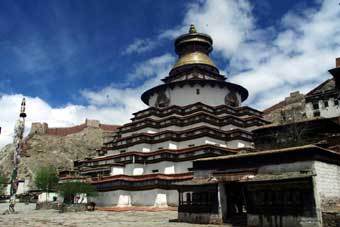For most visitors to the Tibet Autonomous Region, the name Gyantse does not
bring a familiar ring as compared with larger cities like Lhasa, Nyingchi,
Yadong and Xigaze.
But the minor city is a firmly written chapter in Tibet's modern history.

The Palkhor Monastery is famous for its Hundred Thousand
Buddhas Stupa. |
On September 23, local people will gather at a grand memorial ceremony in
memory of those who fought and died in the war of resistance against the British
colonial army 100 years ago.
Since late July, a series of commemorative events have been held. These
include screenings of films about the history of Gyantse, the launching of
historical books and a newly compiled "Annals of Gyantse," public lectures about
Gyantse's history, and song and dance performances.
Local people and visitors have paid homage to the historic sites such as
Mount Dzongri, where the heroic Tibetan soldiers shed their blood and lost their
lives in their last line of defence.
Time-honoured town
Gyantse lies about 90 kilometres to the west of Yamzhog Yumco Lake.
The Nyangchu River rolls swiftly through the Gyantse Valley, on one side
stands the famous ancient Tibetan Buddhist monastery, the Palkhor with its
Stupa, or "Chorten" in Tibetan, of A Hundred Thousand Buddhas.

The imposing Mount Dzongri Castle, standing at the centre
of Gyantse, was a fortified position in
1904. |
The "Palkhor Chorten," after years of construction and expansion, has
collected 10,000 images of Buddha in the form of clay sculptures or paintings.
The structure is one of the ancient Tibetan kings' chortens and has been the
emblem of Gyantse for centuries.
The formal establishment of the ancient town dates back about 600 to 700
years.
In the quiet and fertile river valley, local people made their living by
stock raising and agriculture.
It is said that when Princess Wencheng was sent by Tang emperor Taizong in AD
641 to journey to Tibet and marry the Tubo king Songtsen Gampo, the two giant
men named Lhaga and Luga who pulled the cart carrying the image of Sakyamuni
later settled here.
With the decline of the Tubo Kingdom in the 9th century, Tibet fell into a
period of decentralization for 400 years during which regional chieftains set up
independent principalities.
According to a local document entitled the "Penetration of Buddhism Into the
Nyangchu River Valley" (Nyangchu Jung), the earliest religious king of the
principality, Palkhor Tsenpo, erected a fortress on Mount Dzongri and took up
residence there.
It is said that Palkhor Tsenpo believed that Mount Dzongri and the
geographical features of Gyantse appeared unusual and considered this to be a
good omen.
In the east, it resembled a delicate drooping bough of a
fruit tree, to the south there was a lion about to leap in the air, in the west
floated a white silk scarf, obviously referring to the Nyangchu River roaring
westward, and to the north the land took the shape of a herdsman presenting
livestock products.

